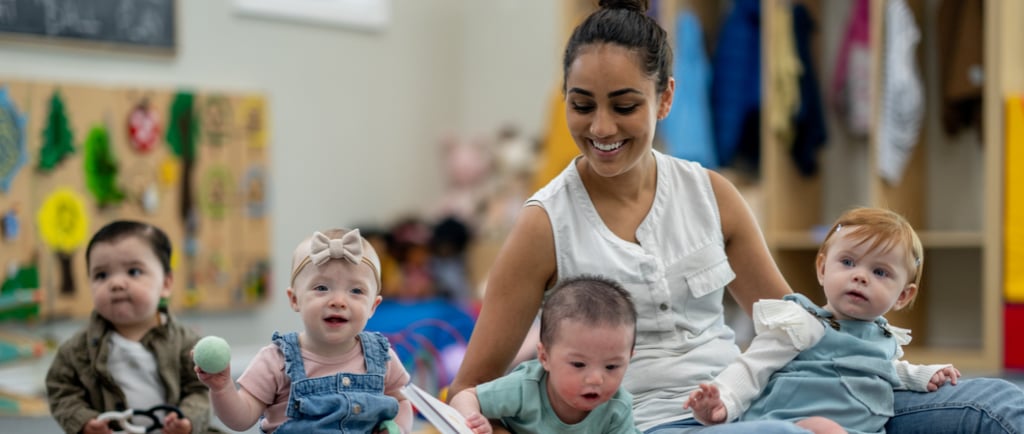The Hidden Toll of Sensory Overload in Children: How Caregivers Can Create Calmer Environments
Many children struggle silently with sensory overload from loud sounds, bright lights, or crowded spaces — especially those with autism, anxiety, or developmental delays. Yet, it’s often misunderstood as “bad behavior.
10/17/20254 min read


Understanding Sensory Overload in Children
Sensory overload is a phenomenon that occurs when an individual's sensory experiences exceed their processing capacity, leading to feelings of discomfort or anxiety. This can be particularly pronounced in children, especially those who are on the autism spectrum, have anxiety disorders, or face developmental delays. Such children may exhibit heightened sensitivity to various stimuli, which can result in overwhelming experiences. Understanding the triggers and manifestations of sensory overload is crucial for caregivers aiming to create supportive environments.
Common triggers of sensory overload include loud noises, intense lighting, crowded spaces, and unexpected movements. For instance, a child might become visibly distressed in a bustling shopping mall, where the cacophony of sounds and bright displays can be disorienting. Similarly, the sound of sirens or loud music might evoke a strong fear response, leading to tantrums or withdrawal. In environments where these stimuli are prevalent, a child may react by covering their ears, shutting their eyes, or seeking refuge in a quieter space.
It is vital to differentiate between sensory overload and typical childhood behavior. While most children occasionally display frustration or seek out changes in their environment, those experiencing sensory overload may exhibit extreme reactions, such as meltdowns or aggressive behavior. Recognizing the signs of sensory overload—such as irritability, avoidance behaviors, or difficulty focusing—enables caregivers to respond appropriately. Proactive support, including reducing exposure to triggering stimuli and creating designated calming spaces, can significantly enhance the well-being of children prone to sensory challenges.
The Importance of Sensory Awareness in Home and Daycare Settings
Understanding sensory awareness is paramount for caregivers, educators, and family members involved in the upbringing of children. Sensory awareness involves recognizing how various stimuli—such as sounds, sights, textures, and smells—can influence a child's emotional and mental well-being. In settings like homes and daycare facilities, sensory experiences shape interactions and learning opportunities, making it essential to maintain an environment that minimizes overstimulation.
Chaotic or overstimulating spaces can aggravate sensory overload, leading to feelings of anxiety, frustration, and discomfort in children. For instance, a brightly lit room filled with loud noises may overwhelm a child who is sensitive to sensory input. This overstimulation can result in behavioral issues, withdrawal, or heightened hostility, adversely affecting the child’s overall development. By fostering a space that is calm and sensory-friendly, caregivers can help mitigate these risks, ultimately promoting a child's emotional stability and capacity to thrive.
The implications for both home and daycare environments are significant. In homes, promising practices include organizing spaces to limit sensory clutter, using soothing color palettes, and incorporating soft furnishings that can help buffer noise. Daycare settings benefit from designated quiet areas, the use of sensory bins filled with tactile materials, and establishing routines that provide predictability amidst daily activities. Being mindful of sensory needs in these environments not only aids in the comfort of children but also enhances their ability to engage in learning and social interactions. A foundational understanding of sensory awareness enables caregivers and educators to construct nurturing spaces conducive to a child’s growth.
Effective Calming Strategies for Sensory Overload
To effectively mitigate sensory overload in children, caregivers can adopt several practical strategies that cater to individual sensory needs. One of the fundamental approaches is the creation of 'quiet corners' within the home or classroom. These designated areas should be equipped with calming materials such as soft cushions, weighted blankets, and noise-canceling headphones. This space should be free of distractions, allowing children to retreat when they feel overwhelmed. Caregivers can encourage children to use these quiet corners as a safe haven to decompress and regain their composure.
Incorporating soft textures into the environment is another critical strategy. Textiles such as plush toys, fleece blankets, and textured cushions can provide tactile experiences that soothe children during periods of sensory overload. It is beneficial to create a selection of these materials readily accessible within the quiet corners, allowing children to engage with them as needed. Caregivers can also introduce sensory bins filled with items such as rice, sand, or foam beads, enabling children to explore different textures and provide an engaging sensory experience that is both calming and enjoyable.
Utilizing visual schedules can further aid in providing predictability and structure, which are vital in reducing anxiety associated with sensory overload. Caregivers should implement a visual timetable that outlines daily activities using images or symbols to represent each task. This approach helps children understand what to expect throughout the day, reducing uncertainty and fostering a sense of security. By regularly reviewing the schedule with the child, caregivers can enhance their child's engagement, ensuring that they are adequately prepared for transitions.
Combining these strategies allows caregivers to create environments that are more accommodating to the sensory needs of children, ultimately leading to more comfortable experiences and promoting better emotional regulation.
The Caregiver's Role in Supporting Emotional Regulation
Caregivers have a crucial role in helping children navigate the complexities of emotional regulation, especially when faced with the challenges posed by sensory overload. Understanding that each child's sensory preferences and triggers can vary widely is essential for tailoring support effectively. By observing children's reactions to various stimuli, caregivers can identify patterns that indicate when a child is feeling overwhelmed. This awareness equips them to respond promptly when signs of distress arise.
Modeling calm behavior is one of the most effective techniques caregivers can employ. Children often mimic the emotional responses of adults, so maintaining a composed demeanor can influence the child’s emotional state positively. When caregivers approach situations with a sense of calm, children are more likely to replicate these behavior responses, fostering an environment conducive to emotional regulation.
Encouraging open communication about feelings is equally important in supporting emotional regulation. Caregivers should create spaces where children feel safe expressing their emotions without fear of judgment. Facilitating conversations about feelings stretches beyond merely asking about their day; it involves actively listening and validating their experiences. Engaging in dialogues that explore sensory experiences can help children articulate their discomfort or anxiety, offering caregivers insight into how to best alleviate distress.
Furthermore, creating a supportive atmosphere entails providing comfort and reassurance. Caregivers can employ various strategies, such as offering sensory tools, establishing calming routines, or providing quiet spaces where children can retreat to when overwhelmed. Tailoring these strategies to each child's needs will enhance their emotional resilience, ultimately enabling them to cope more effectively with sensory challenges. Through this multi-faceted approach, caregivers play an integral role in not only alleviating immediate distress but also in fostering long-term skills for emotional regulation.
Contacts
844-228-4441
info@avanta.care
Subscribe to our newsletter
Servicing
All of Georgia
All of Florida
All of Maine
All of South Carolina
All of Vermont.
